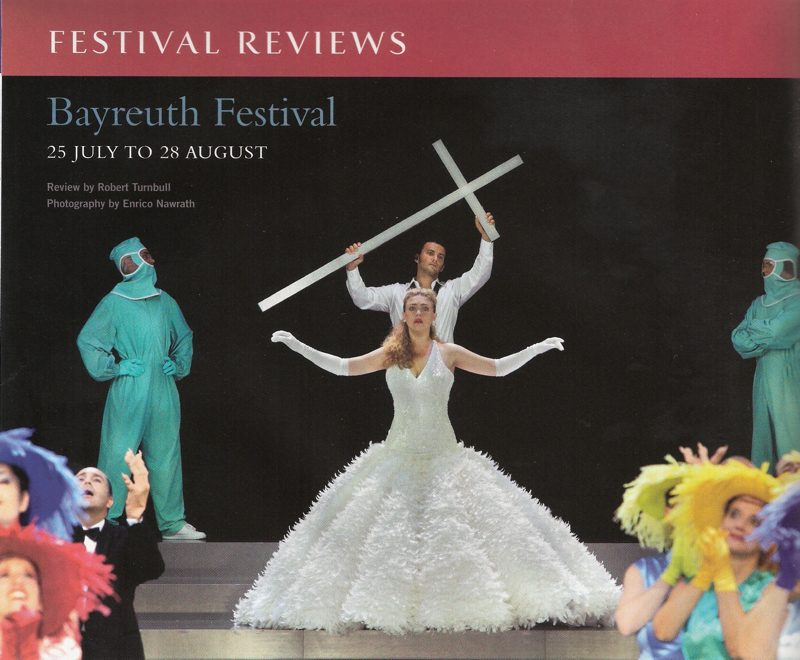|
 THE FESTIVAL'S NEW PRODUCTION THIS YEAR, Lohengrin, is enough to challenge
even a seasoned reviewer, let alone anyone unfortunate enough to come to
this opera for the first time. As with Herheim's Parsifal, there were two
narratives working concurrently, one dystopian, the other erotic, but in
this case we were subjected to the whims of a German director determined to
sew controversy. The 69-year-old Hans Neuenfels is perhaps most famous for
incorporating roast chickens into his Aida and for using Mohammed's head in
Idomeneo, which caused a storm of protest. THE FESTIVAL'S NEW PRODUCTION THIS YEAR, Lohengrin, is enough to challenge
even a seasoned reviewer, let alone anyone unfortunate enough to come to
this opera for the first time. As with Herheim's Parsifal, there were two
narratives working concurrently, one dystopian, the other erotic, but in
this case we were subjected to the whims of a German director determined to
sew controversy. The 69-year-old Hans Neuenfels is perhaps most famous for
incorporating roast chickens into his Aida and for using Mohammed's head in
Idomeneo, which caused a storm of protest.
We first encounter
Lohengrin during the opera's prelude, desperately trying to escape through a
locked door. Once in Brabant, he emerges less as an emissary of the grail
than an office worker, ie normal guy, who on encountering the lovely Elsa
demonstrates very human insecurities. He fidgets nervously and throws
himself at her like a lost and lonely man begging for love and approval. The
consequences of Elsa's probing questions and Lohengrin's demand for
unconditional love are recognisable human themes played out effectively in
the final act of the production. Wagner considered this to be his saddest
opera. With some sensitive acting from the two principals the erotic power
of the last act is considerable (though Patrice Chéreau might have done it
better).
Had Neuenfels been content with telling this story, the
evening might have been less excruciating. The set is brightly lit and
clinical, a laboratory in which a ghastly experiment has turned the people
of Brabant into rats, but apparently happy, well-dressed rodents with pretty
pink tails. Yes, you've got it: the people of Brabant, like much of modern
humanity have become clones, arch consumers who will eat (or buy) anything
put in front of them and follow leaders willy nilly. These rats, moreover,
share childish humour, break dance and high five like high school kids. We
are all becoming Americans!
The symbolism continues. Elsa has arrows
stuck in her back, all of which Lohengrin removes. The swan which returns to
collect our hero from his predicament is in fact an egg, out of which
emerges a fully formed embryo which scatters its umbilical chord around the
stage like lumps of bratwurst.
Of course at Bayreuth there were
musical compensations. Opera's current sex symbol Jonas Kaufmann
used his beautiful and dark hued voice to glorious effect especially in the
final duet. In this he was matched by the burnished tones of the
Elsa of Annette Dasch. Evelyn Herlitzius (who sang Ortrud) has a boom in her
voice that suits the part, but this small-framed singer should be careful.
She is already developing a wide vibrato and her top notes are sharp. The
likeness to the British dramatic soprano Gwyneth Jones during her heyday is
remarkable. Sadly, her intensity wasn't matched by the Telramund of
HansJoachim Ketelson.
The Latvian conductor Andris Nelsons gave a
thrilling and passionate reading of the score, full of telling detail in the
woodwind and brass and shimmering strings. Like Semyon Bychkov at the Royal
Opera last year Nelsons managed to create soft cushions of sound, allowing
the principals maximum flexibility in phrasing and dynamics. It's just a
pity that his first attempt at this opera should have come with this
production.
|